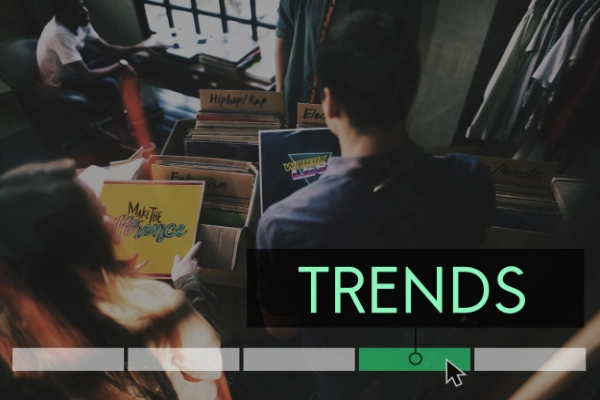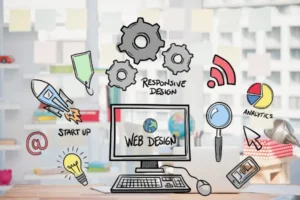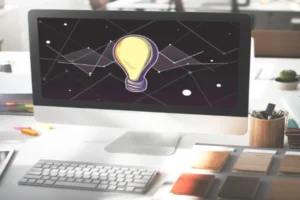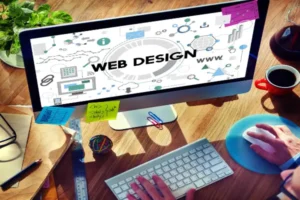The world of web design is constantly evolving, with new technologies, user expectations, and creative possibilities shaping the landscape. As we move into 2024, designers are pushing the boundaries of what’s possible, creating visually captivating, functional, and user-centric websites. In this blog, we’ll explore the top 10 web design trends you should look out for this year to keep your websites fresh, innovative, and user-friendly.
1. Dark Mode Dominance
Dark mode has been gaining traction over the last few years, and in 2024, it is set to become even more popular. Offering a sleek and modern look, dark mode also provides benefits for users, such as reducing eye strain, especially in low-light environments.
Why It’s Trending:
- User preference: Many users are opting for dark mode because it’s easier on the eyes and enhances readability.
- Battery-saving: On OLED screens, dark mode can help save battery life.
- Visual appeal: Dark mode can make colorful elements pop, creating a more engaging experience.
Best Practices:
- Offer users the ability to toggle between light and dark modes.
- Ensure sufficient contrast for readability, especially with text and images.
2. Minimalist and Clean Designs
Minimalism continues to dominate web design in 2024. By stripping away unnecessary elements, minimalist websites focus on clean, intuitive navigation, allowing users to focus on what’s important: the content.
Why It’s Trending:
- Faster loading times: A simpler design requires fewer resources and can load faster.
- Better user experience: Clear, uncluttered designs are easier to navigate and more visually appealing.
- Focus on content: With fewer distractions, the content takes center stage.
Best Practices:
- Use a lot of white space to allow the content to breathe.
- Limit the use of colors and fonts to create a cohesive, organized feel.
- Prioritize intuitive navigation with minimal clicks.
3. Immersive 3D and Augmented Reality (AR)
Advancements in technology are bringing 3D and AR elements into web design, offering more interactive and immersive experiences. Whether it’s rotating products, interactive environments, or AR features, these elements are elevating user engagement.
Why It’s Trending:
- Enhanced user engagement: 3D elements and AR create a more interactive and memorable experience.
- Better product visualization: AR allows users to see products in their environment, improving their decision-making process.
- Technological advancements: More accessible tools and technologies are enabling the implementation of AR on websites.
Best Practices:
- Implement 3D elements sparingly to avoid overwhelming the user.
- Ensure AR experiences are accessible across different devices and browsers.
- Keep performance in mind—3D and AR elements should be optimized to avoid slow loading times.
4. Advanced Typography
Typography is becoming more expressive, with designers using creative fonts, text animations, and varying font weights to create visually appealing layouts. In 2024, typography is playing a central role in enhancing the overall design aesthetic and user experience.
Why It’s Trending:
- Improved readability: Modern fonts and variable typography improve readability and accessibility.
- Branding: Custom fonts can help reinforce brand identity.
- Dynamic design: Animated and interactive typography adds a layer of engagement.
Best Practices:
- Choose fonts that are legible across all devices and screen sizes.
- Experiment with text animations to add personality without compromising readability.
- Use large, bold typography to highlight key messages and calls to action.
5. Microinteractions and Animations
Microinteractions refer to small, subtle animations or transitions that guide users through their journey. These interactions can include hover effects, button animations, or page load animations, all of which enhance the user experience by providing feedback and making the website feel more interactive.
Why It’s Trending:
- Engagement: Microinteractions can grab user attention and make navigation feel more intuitive.
- User feedback: They provide visual cues to users, confirming actions or indicating loading processes.
- Increased brand personality: Custom animations help to reinforce brand identity and make the website more memorable.
Best Practices:
- Keep animations smooth and non-distracting to avoid overwhelming the user.
- Ensure animations don’t hinder the website’s performance or accessibility.
- Focus on feedback-driven animations (e.g., button hover states, form submission animations).
6. Voice User Interface (VUI)
As voice assistants like Siri, Alexa, and Google Assistant continue to grow in popularity, voice user interfaces (VUI) are becoming a critical part of web design. VUI allows users to navigate a website using their voice, providing an alternative to traditional mouse-and-keyboard interactions.
Why It’s Trending:
- Convenience: Voice search is faster and more convenient, especially on mobile devices.
- Hands-free navigation: Voice commands make it easier for users to interact with a website without needing to touch the screen.
- Technological innovation: More websites are incorporating VUI to stay ahead of the curve.
Best Practices:
- Ensure clear, easy-to-understand prompts for voice navigation.
- Include voice search options to make finding content faster.
- Make VUI an optional feature; users should be able to opt-out if they prefer traditional navigation.
7. Dark Mode and Light Mode Toggle
Having both dark mode and light mode as options for website visitors is becoming an essential feature. Many users prefer a more customized experience, and this toggle ensures the website is accessible to everyone, regardless of lighting preferences.
Why It’s Trending:
- Personalization: Users appreciate being able to switch between dark and light modes based on their preference or environment.
- Accessibility: Users with visual impairments or light sensitivity benefit from customizable modes.
- User retention: Providing a better, tailored experience keeps users engaged for longer periods.
Best Practices:
- Make sure the transition between modes is seamless and doesn’t affect the user experience.
- Test both modes for accessibility, ensuring text and background contrasts meet WCAG guidelines.
- Offer the mode toggle prominently on the site for easy access.
8. Neomorphism and Glassmorphism
Neomorphism and glassmorphism are both emerging visual design trends that combine depth, gradients, and transparency to create a sense of realism. Neomorphism uses soft shadows and rounded edges to mimic physical surfaces, while glassmorphism uses frosted-glass effects to create transparency and depth.
Why It’s Trending:
- Futuristic appeal: These trends provide a modern, high-tech look that feels futuristic.
- Depth and focus: Neomorphism creates a sense of depth while maintaining a clean and minimalistic style.
- Soft, organic visuals: Glassmorphism evokes a sense of transparency and fluidity, enhancing a smooth user experience.
Best Practices:
- Use these effects sparingly, as they can be overdone easily.
- Focus on creating a tactile feel with subtle shadows and textures.
- Ensure these design styles don’t hinder readability or accessibility.
9. AI-Powered Design
Artificial intelligence is transforming the web design process, offering tools that automate tasks like layout creation, content generation, and even personalized design recommendations. AI is helping designers work more efficiently and create websites that are tailored to users’ needs and behaviors.
Why It’s Trending:
- Efficiency: AI can automate repetitive tasks, speeding up the design process.
- Personalization: AI allows for hyper-personalized user experiences based on behavior and preferences.
- Data-driven design: AI can analyze user data to suggest design elements that improve engagement and conversions.
Best Practices:
- Use AI tools for tasks like content generation, SEO optimization, and performance tracking.
- Don’t rely solely on AI for creative decision-making; balance AI recommendations with human intuition.
- Ensure AI-powered features respect user privacy and data security.
10. Sustainability in Web Design
Sustainability is becoming a priority in every industry, and web design is no exception. With a growing focus on reducing the carbon footprint of websites, designers are looking for ways to create energy-efficient websites that are faster, smaller in size, and less resource-intensive.
Why It’s Trending:
- Environmental impact: The digital world consumes significant energy, and web designers are finding ways to reduce that impact.
- Faster websites: Optimizing websites for energy efficiency often leads to faster loading times and better performance.
- Ethical responsibility: Many businesses are now prioritizing sustainability, and this includes their digital presence.
Best Practices:
- Optimize images and videos for faster loading times without compromising quality.
- Choose lightweight frameworks and reduce excessive scripts to minimize resource usage.
- Implement best practices for energy-efficient hosting and content delivery networks (CDNs).
Conclusion
As we move into 2024, web design trends are all about enhancing the user experience, embracing new technologies, and creating more personalized and engaging websites. From dark mode to AI-powered designs and immersive 3D experiences, the landscape is rapidly evolving. Staying ahead of these trends can help ensure your websites remain modern, functional, and user-friendly.
Are you ready to implement these trends into your own web design? Start experimenting today and create websites that stand out in 2024!







